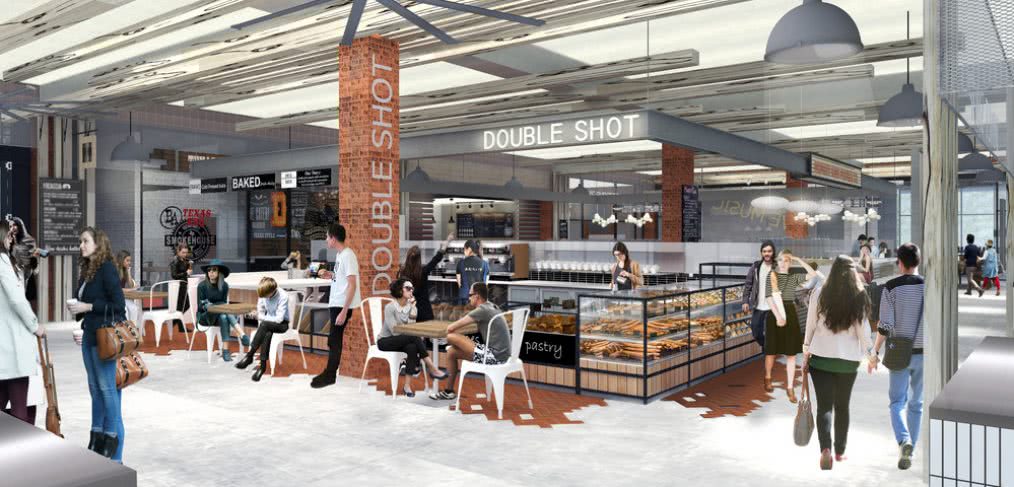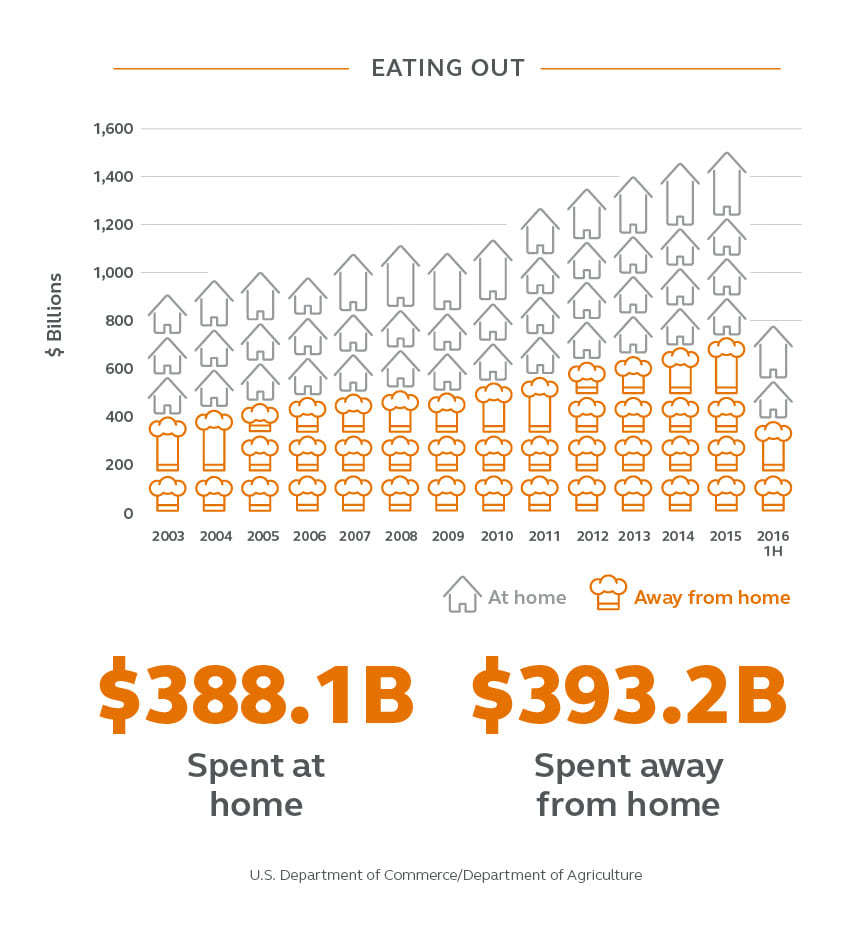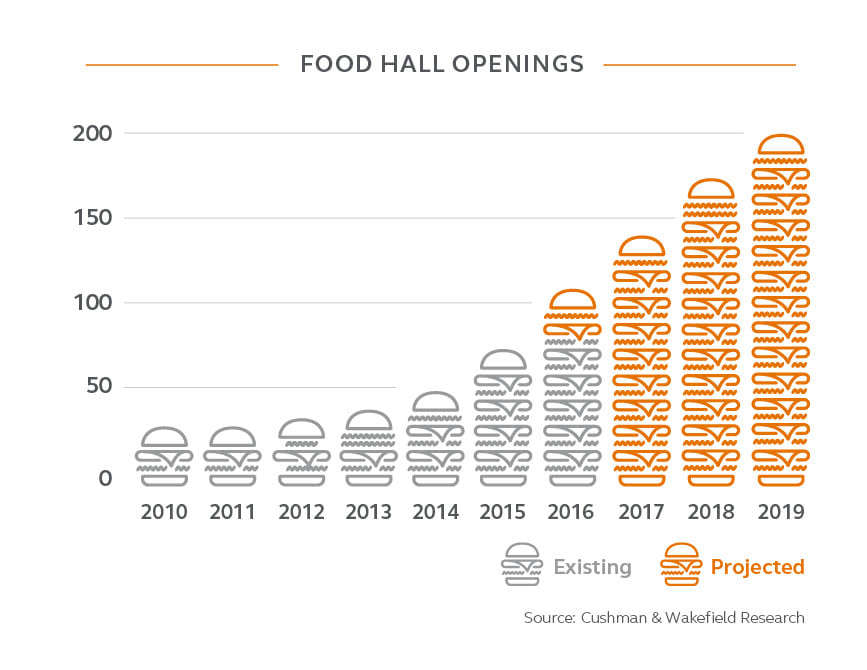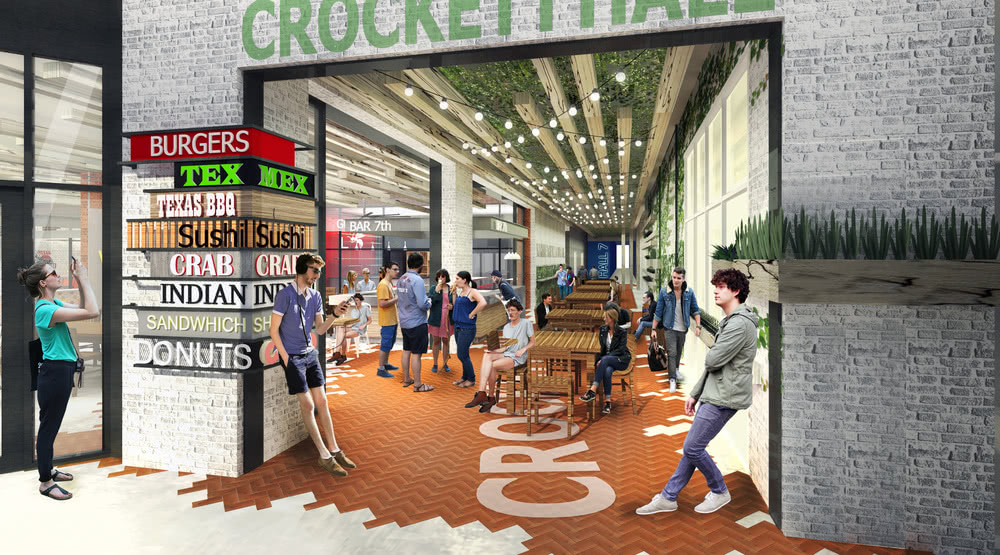
DATÜM: Food Halls – The Special Sauce in Retail
If the rumors are true (they aren’t) and traditional retail is dead (it isn’t), then what has taken its place? What is getting us out of the house, off our sofas and into the public square? Food and events centered around dining and cuisine are the new social driver bulldozing the commercial landscape. But these aren’t the food halls—or even the restaurants—of yesteryear. We’re talking dynamic new formats and approaches that focus on quality, socialization and community.
Rising Influence of Food Retail
From an economic standpoint, food halls are an easy sell to other retail tenants since Instagramming your meals and Snapchatting your lunch date is a top priority. These popular spaces draw foodies and crowds that spend their leisure time eating and socializing. The dining spaces are furnished with an eclectic mix of seating and materials and create a unique, local experience that traditional food courts of Cinnabon and questionable fast-casual Chinese joints have been unable to provide. • In some regions of the U.K., Canada and U.S., the amount of space in properties dedicated to F&B is forecast to reach up to 20 percent or more of total space by 2025 (and it could surpass 30 percent in Asia) [source: ICSC, 2017]
• In some regions of the U.K., Canada and U.S., the amount of space in properties dedicated to F&B is forecast to reach up to 20 percent or more of total space by 2025 (and it could surpass 30 percent in Asia) [source: ICSC, 2017]
• The number of food halls grew by 37 percent to 105 in 2016 and is predicted to double by 2019 in the U.S. [source: Cushman & Wakefield, 2016]
 Food Halls That Inspire
Food Halls That Inspire
We’ve established that food halls are popular, but what is it that entices us? Let’s dive in.
Where It All Started
Eataly was created in 2007 and has continued to rapidly grow. Founder, Oscar Farinetti, turned an old vermouth factory in Turin, Italy, into his first food hall. His goal was to create a space where buyers could eat, learn and shop under the same roof. Who doesn’t love to sample Italian wines, snack on small plates and learn about cured meats and cheeses? His venture is now global, and he continues to dream bigger.
Farinetti is upping the ante with his biggest project to date: Eataly World in Bologna, Italy. The culinary theme park will have 40 food and beverage options, truffle-hunting dogs and on-site cows producing various dairy products. Mooooo-ve over.
From Fast Food to Artisanal Offerings
Todd’s English Food Hall at the Plaza Hotel in New York City opened its doors in 2010. A lot of markets at the time were tourism based or focused on efficiency, not quality. English decided to step out of the box and create a European-inspired food hall. English’s place offers world-class culinary options, as well as prepared foods that are of high quality. Todd’s English, along with Eataly, was the first to kick off the ever-expanding food hall trend we see today.
Dine and Lounge – Linger Longer
 The 16,000SF, CallisonRTKL designed Crocket Food Hall in Fort Worth, Texas combines indoor and outdoor seating with an open and modern atmosphere. The paseo functions as a beer hall in the evening and walk up to-go windows. You can choose from casual and formal dining options, along with live music. The 16,000SF space will have 14 eateries, with Knife Burger as the anchor restaurant.
The 16,000SF, CallisonRTKL designed Crocket Food Hall in Fort Worth, Texas combines indoor and outdoor seating with an open and modern atmosphere. The paseo functions as a beer hall in the evening and walk up to-go windows. You can choose from casual and formal dining options, along with live music. The 16,000SF space will have 14 eateries, with Knife Burger as the anchor restaurant.
Getting To Know Your Neighbor
Mercado Roma in Mexico City, Mexico, brings back the original setting of purchasing produce, home goods, specialty items, etc. from the trader himself. With more than 50 merchants across three floors, the buyer can take their time perusing, while also getting to know vendors directly. This laidback and personal environment draws in the locals and makes Mercado Roma a popular destination.
Inventing The Ultimate Food Hall
Re-inventing is easier when inspiration is drawn from the local culture and environment. That’s what makes food halls thrive: the originality and connection to the community.
- Locavore
- A key to food hall success is to not create the same model and design in multiple cities. It’s a food hall, not a mall cafeteria. The main attraction of these spaces is that they are authentic and tuned into the local flavor of the residents so that the visitors can get an exclusive look at what that city or neighborhood represents. Local is the name of the game.
- Smaller Footprints, Urban Scale
- No longer are these food halls taking up a ton of valuable square footage – now, we’re seeing smaller food halls that cater to urban dense developments. These hyper-localized food halls and start-up like atmospheres are a perfect way to tailor the offerings to the community it serves.
- Easily Navigable
- Streamlined and devoid of clutter. It should be easy for people to navigate through the space, especially in a time crunch, but also cater to those dining in and taking their time. A mix of seating (social, open and semi-private) to accommodate the slow and on-the-go movement, where brunch turns into drinks and dinner. Also, furniture that can accommodate diners seamlessly from morning to late night hours allows the space to be used for all types of goers.
- The Show Must Go On
- With open layouts and visibility being key factors, it’s no surprise that open kitchens are common. It’s a way to make the experience feel more personalized; the customer can see what and how you make their meal. It also guarantees a higher level of customer satisfaction for those particular folks.
